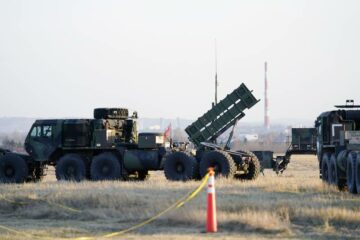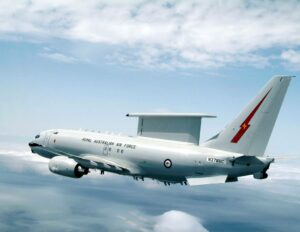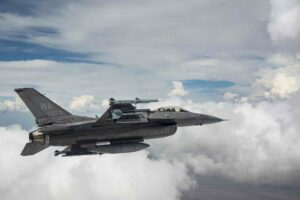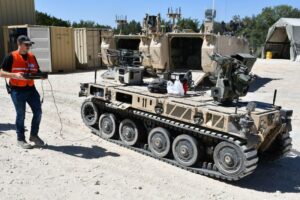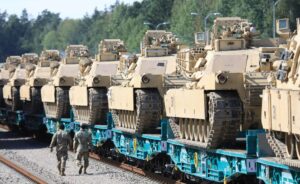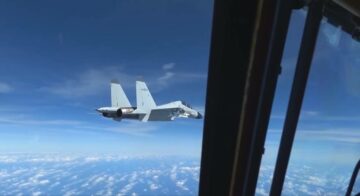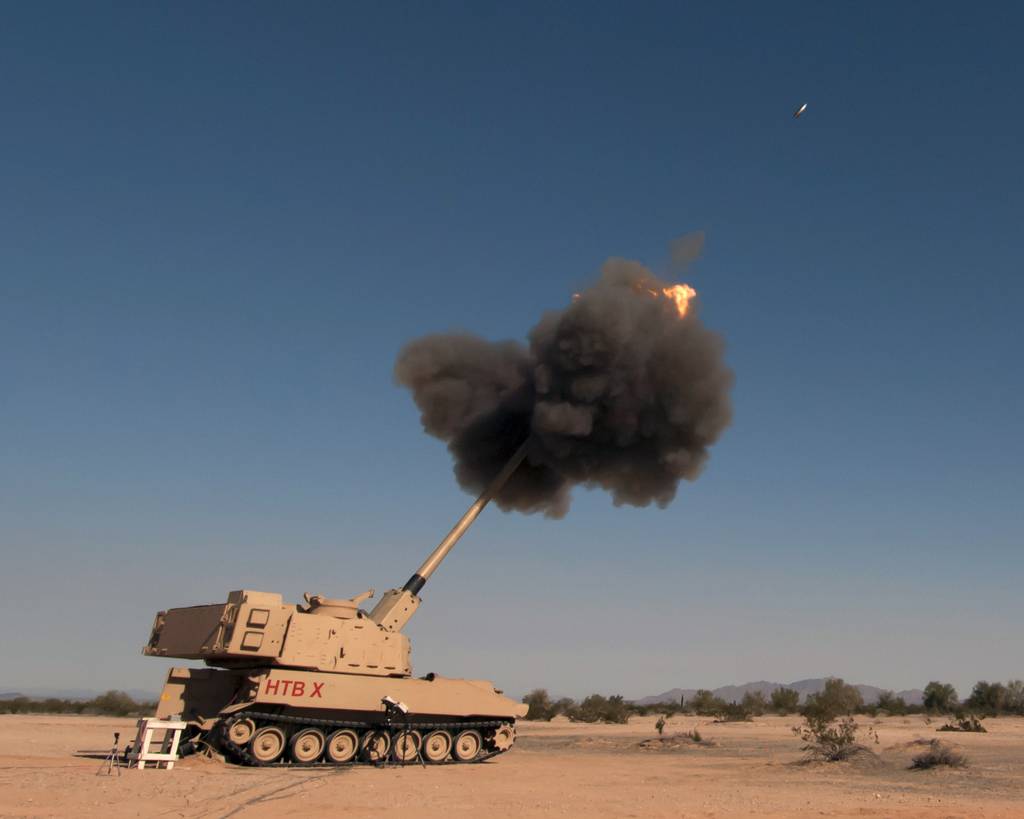
WASHINGTON — The U.S. Army expects to choose a single provider for its Tactical Intelligence Targeting Access Node, a battle-management system, early next year, according to program officials.
The program, dubbed TITAN, has been moving through a 14-month rapid prototyping phase, during which RTX, formerly Raytheon, and Palantir Technologies demonstrated competing systems. That effort culminated this summer with a demonstration — called a soldier touchpoint — and acceptance test, aimed at assessing the two systems’ technical performance and usability.
Brig. Gen. Ed Barker, the service’s program executive officer for intelligence, electronic warfare and sensors, told reporters Dec. 5 that those summer demonstrations will inform which of the prototypes the Army chooses to field. That decision, he added, is expected between January and March.
“The selected vendor will further mature their prototype through more soldier touchpoints,” he said during a media briefing. “And then we intend to have some of this capability issued to designated units to allow them to refine the feedback and the [tactics, techniques and procedures] in which it would be employed.”
TITAN is an intelligence ground system, designed to help the Army connect data-gathering sensors to shooters in the field to support advanced beyond-line-of-sight targeting. In 2021, the Army chose designs from RTX and Palantir and in 2022 awarded $36 million to both companies to turn their plans into prototypes.
The winning contractor will develop two variants of the system: advanced and basic. The former will integrate with tactical trucks, such as the Family of Medium Tactical Vehicle fleet’s M1083, and will have the ability to ingest sensor data from space systems. The basic variant will be installed on the Army’s Joint Light Tactical Vehicle and won’t have the space downlink package, but Barker noted that it will have access to data from space sensors.
Northrop Grumman is developing the space kit through a partnership with the Defense Innovation Unit.
The chosen prototype will be deployed to an Army unit that will familiarize itself with the system and provide feedback on potential changes, Barker said. By 2026, he noted, the service hopes to have a decision on whether the capability will transition into a formal acquisition program, a phase referred to as a major capability acquisition pathway.
As the Army eyes the upcoming TITAN decision point, it’s also considering how the system might be integrated within its portfolio and how that could impact other modernization initiatives.
“We’re going through a lot of different exercises from a network standpoint in understanding where things are going to go at echelon and what that means for our existing modernization efforts,” Barker said, adding that the process could help determine how many basic and advanced TITAN systems the Army will need.
“A lot of that is going to depend on the various efforts that are going on right now to really flesh it out . . . as well as the different tabletop exercises that are going on within the Army to determine what that network will look like and then essentially where things will fall form a functional standpoint.”
Courtney Albon is C4ISRNET’s space and emerging technology reporter. She has covered the U.S. military since 2012, with a focus on the Air Force and Space Force. She has reported on some of the Defense Department’s most significant acquisition, budget and policy challenges.
Colin Demarest is a reporter at C4ISRNET, where he covers military networks, cyber and IT. Colin previously covered the Department of Energy and its National Nuclear Security Administration — namely Cold War cleanup and nuclear weapons development — for a daily newspaper in South Carolina. Colin is also an award-winning photographer.
- SEO Powered Content & PR Distribution. Get Amplified Today.
- PlatoData.Network Vertical Generative Ai. Empower Yourself. Access Here.
- PlatoAiStream. Web3 Intelligence. Knowledge Amplified. Access Here.
- PlatoESG. Carbon, CleanTech, Energy, Environment, Solar, Waste Management. Access Here.
- PlatoHealth. Biotech and Clinical Trials Intelligence. Access Here.
- Source: https://www.defensenews.com/battlefield-tech/it-networks/2023/12/06/titan-targeting-contract-to-be-awarded-soon-army-officials-say/
- :has
- :is
- :where
- 17
- 2012
- 2021
- 2022
- 2026
- 70
- a
- ability
- acceptance
- access
- Access to data
- According
- acquisition
- added
- adding
- administration
- advanced
- aimed
- AIR
- Air Force
- allow
- also
- an
- and
- ARE
- Army
- AS
- Assessing
- At
- award-winning
- awarded
- basic
- BE
- been
- between
- both
- Briefing
- budget
- but
- by
- called
- capability
- Carolina
- challenges
- Changes
- Choose
- chose
- chosen
- cold
- Companies
- competing
- Connect
- considering
- contract
- Contractor
- Convergence
- could
- covered
- covers
- cyber
- daily
- data
- dec
- decision
- Defense
- delivered
- demonstrated
- Department
- Department of Energy
- depend
- deployed
- designated
- designed
- designs
- Determine
- develop
- developing
- Development
- different
- dubbed
- during
- Early
- ed
- effort
- efforts
- Electronic
- emerging
- Emerging Technology
- employed
- energy
- essentially
- executive
- Executive Officer
- existing
- expected
- expects
- Eyes
- Fall
- familiarize
- family
- feedback
- field
- Focus
- For
- Force
- form
- formal
- Former
- formerly
- from
- functional
- further
- Gen
- Go
- going
- Ground
- Have
- he
- help
- hopes
- How
- HTTPS
- images
- Impact
- in
- inform
- Innovation
- integrate
- integrated
- Intelligence
- intend
- into
- Issued
- IT
- ITS
- itself
- January
- joint
- jpg
- kit
- light
- like
- Look
- look like
- Lot
- major
- many
- March
- mature
- means
- Media
- medium
- might
- Military
- million
- Mobile
- modernization
- more
- most
- moving
- namely
- National
- Need
- network
- networks
- next
- node
- noted
- now
- nuclear
- Nuclear weapons
- of
- Officer
- officials
- on
- our
- out
- package
- Partnership
- pathway
- performance
- phase
- photographer
- plans
- plato
- Plato Data Intelligence
- PlatoData
- Point
- policy
- portfolio
- potential
- previously
- procedures
- process
- Program
- project
- prototype
- prototypes
- prototyping
- provide
- provided
- provider
- rapid
- really
- referred
- refine
- Reported
- reporter
- right
- rtx
- s
- Said
- say
- security
- selected
- sensor
- sensors
- service
- she
- significant
- since
- single
- some
- Soon
- South
- South carolina
- Space
- Space Force
- standpoint
- such
- summer
- support
- system
- Systems
- tactical
- tactics
- targeting
- Technical
- techniques
- Technologies
- Technology
- test
- that
- The
- their
- Them
- then
- things
- this
- those
- Through
- titan
- to
- told
- transition
- Trucks
- TURN
- two
- u.s.
- understanding
- unit
- units
- upcoming
- usability
- Variant
- various
- vehicle
- vendor
- war
- we
- Weapons
- WELL
- What
- whether
- which
- will
- winning
- with
- within
- would
- year
- zephyrnet



